Oxford, MS: Unlocking Innovation in Septic Upgrades
November 30, 2023
Demystifying Septic Tank Upgrades: Exploring Innovative Technologies in Oxford, MS
Nestled in the heart of Mississippi, the charming town of Oxford is known for its rich history, vibrant culture, and a strong sense of community. Oxford residents take great pride in their homes, not only for their aesthetics but also for their functionality. One often underestimated aspect of home maintenance is the septic system. Responsible for the treatment and disposal of wastewater, septic systems are the unsung heroes of maintaining a clean and healthy living environment. In this comprehensive blog post, we'll delve into the fascinating world of septic tank upgrades, exploring innovative technologies available through Oxford Septic Service.
The Evolution of Septic Systems
Before we embark on our journey to explore the latest septic tank technologies, it's important to understand how these systems have evolved over time. The traditional septic system, while effective, has seen significant improvements aimed at enhancing efficiency, reducing environmental impact, and simplifying maintenance.
A conventional septic system typically comprises three primary components:
Septic Tank: Wastewater from your home flows into the septic tank, where solids settle at the bottom, and scum floats to the top. The tank's primary function is to separate and partially treat the wastewater.
Drain Field: After leaving the septic tank, liquid effluent is distributed into a drain field, where it percolates through the soil and undergoes further treatment.
Pipes and Distribution Box: A network of pipes and a distribution box evenly distribute effluent in the drain field.
Now, let's explore how innovation has impacted these systems and what homeowners in Oxford can expect in terms of upgrades.
Advancements in Septic Tank Technology
In recent years, septic tank technology has undergone remarkable transformations, resulting in more efficient, eco-friendly, and user-friendly systems. Here are some key innovations:
1. Aerobic Treatment Units (ATUs)
ATUs are advanced septic systems that introduce oxygen into the treatment process. By enhancing microbial activity, they break down wastewater more effectively, resulting in cleaner effluent. ATUs can be a valuable upgrade option for Oxford homeowners looking to enhance the treatment efficiency of their septic systems.
2. High-Efficiency Septic Tanks
Modern septic tanks are designed with efficiency in mind. They often incorporate features such as baffle systems to prevent solids from escaping into the drain field and effluent filters to trap debris. These improvements reduce the risk of drain field clogs and extend the system's lifespan.
3. Dosing Systems
Dosing systems regulate the flow of effluent into the drain field, ensuring a consistent distribution of wastewater. This technology prevents overloading the drain field, which can lead to system failure. Dosing systems are particularly beneficial for homes with variable water usage.
4. Alternative Drain Field Designs
Innovative drain field designs, such as gravel-less systems or proprietary chambers, offer improved treatment and disposal of wastewater. These alternatives can be ideal for properties with limited space or challenging soil conditions, which are common considerations in Oxford.
Septic Tank Monitoring and Maintenance Technologies
In addition to advancements in septic tanks themselves, technology has also revolutionized the way septic systems are monitored and maintained:
1. Smart Monitoring Systems
Smart monitoring systems, equipped with sensors, provide real-time data on the health and performance of your septic system. Oxford homeowners can remotely access this information through smartphone apps or web platforms. These systems offer early warning of potential issues, allowing for timely intervention and preventing costly repairs.
2. Septic Tank Additives
Biological additives, such as enzymes and bacteria, can be introduced into the septic system to enhance its efficiency. These additives help break down solids and promote the growth of beneficial microorganisms. However, it's essential to use these products cautiously, as improper use can disrupt the balance of the system.
3. Effluent Filtration Systems
Effluent filters, placed at the outlet of the septic tank, capture small particles and solids before they enter the drain field. These filters reduce the risk of clogs and extend the life of the drain field, promoting the overall health of the system.
Eco-Friendly Septic System Innovations
Oxford, with its commitment to preserving the environment, is an ideal place for homeowners to explore eco-friendly septic system upgrades. Here are some innovative technologies that align with this vision:
1. Greywater Recycling
Greywater recycling systems capture and treat water from sources such as showers, sinks, and washing machines. This treated greywater can then be reused for non-potable purposes like landscape irrigation. Not only does this reduce water consumption, but it also lessens the load on the septic system, making it an eco-conscious upgrade.
2. Biofilters
Biofilters are environmentally friendly alternatives to traditional drain fields. These systems use natural processes to filter and treat wastewater, reducing the environmental impact of septic systems. By enhancing the biological treatment of wastewater, biofilters can help

Septic tank pumping is a crucial aspect of septic system maintenance that often goes overlooked by property owners. Regular pumping helps prevent costly repairs, prolongs the lifespan of the septic system, and protects the environment from contamination. In this guide, Oxford Septic Services shares valuable insights into the importance of routine septic tank pumping and its many benefits. Chapter 1: Understanding the Role of Septic Tank Pumping Overview of the septic tank pumping process and its significance in maintaining a healthy septic system Explanation of how septic tank pumping removes accumulated solids and sludge from the tank, preventing clogs and backups Chapter 2: Preventing Costly Repairs and System Failures Discussion of the potential consequences of neglecting septic tank pumping, including system backups, drain field damage, and groundwater contamination Exploration of the financial implications of septic system repairs and replacements compared to the relatively low cost of routine pumping Chapter 3: Extending the Lifespan of Your Septic System Explanation of how regular septic tank pumping helps prolong the lifespan of the septic system by reducing stress on system components and preventing premature failure Discussion of the correlation between routine pumping and the overall health and longevity of the septic system Chapter 4: Protecting the Environment and Public Health Examination of the environmental and public health risks associated with untreated wastewater discharge from poorly maintained septic systems Explanation of how routine septic tank pumping helps mitigate these risks by preventing groundwater contamination and protecting local water sources Chapter 5: Maintaining Property Value and Resale Potential Exploration of the impact of a well-maintained septic system on property value and resale potential Discussion of how routine septic tank pumping demonstrates responsible property ownership and can increase buyer confidence during real estate transactions Chapter 6: Ensuring Regulatory Compliance Overview of local regulations and requirements regarding septic system maintenance and pumping frequency Explanation of how routine septic tank pumping helps property owners remain in compliance with regulatory standards and avoid potential fines or penalties Chapter 7: Best Practices for Scheduling Septic Tank Pumping Recommendations for establishing a regular pumping schedule based on factors such as household size, water usage, and septic system capacity Tips for working with professional septic service providers like Oxford Septic Services to schedule timely and efficient pumping services Conclusion: Routine septic tank pumping is an essential aspect of responsible septic system ownership, offering numerous benefits for property owners, the environment, and public health. By understanding the importance of routine pumping and working with trusted professionals like Oxford Septic Services, property owners can ensure the long-term performance and reliability of their septic systems.

Installing a septic system is a critical step in ensuring proper wastewater management for residential and commercial properties. However, the installation process can be complex and requires careful planning and execution. In this comprehensive guide, Oxford Septic Services provides essential information and expert tips for homeowners and property owners considering septic system installation. Chapter 1: Understanding the Basics of Septic Systems Overview of septic systems and their components, including the septic tank, drain field, and distribution box Explanation of how septic systems function to treat and dispose of wastewater on-site, without access to a municipal sewer system Chapter 2: Assessing Site Conditions and Permitting Requirements Guidance on assessing soil conditions, topography, and site suitability for septic system installation Explanation of the permitting process and regulatory requirements for septic system installation, including obtaining necessary permits and approvals from local authorities Chapter 3: Designing the Septic System Overview of the steps involved in designing a septic system, including determining system size, layout, and location Discussion of factors to consider when designing a septic system, such as property size, soil type, and groundwater levels Chapter 4: Selecting and Installing Septic System Components Explanation of the different types of septic tanks, drain fields, distribution boxes, and other system components available for installation Step-by-step instructions for properly installing septic system components, including excavation, tank placement, piping installation, and backfilling Chapter 5: Ensuring Proper System Ventilation and Plumbing Connections Importance of providing adequate ventilation for the septic system to prevent the buildup of harmful gases, such as methane and hydrogen sulfide Guidelines for properly connecting plumbing fixtures, such as toilets, sinks, and showers, to the septic system to ensure efficient wastewater flow Chapter 6: Conducting Final Inspections and Testing Overview of the final inspection and testing process to ensure that the septic system meets all regulatory requirements and functions properly Explanation of common tests conducted during the final inspection, such as hydraulic load testing, dye testing, and soil percolation testing Chapter 7: Maintaining and Caring for Your New Septic System Recommendations for ongoing maintenance and care of the newly installed septic system, including routine pumping, inspection, and monitoring Tips for avoiding common pitfalls and ensuring the long-term reliability and performance of the septic system Conclusion: By following the guidelines and expert tips provided in this guide, property owners can navigate the septic system installation process with confidence. With careful planning, proper design, and professional installation by Oxford Septic Services, property owners can ensure the reliable operation and longevity of their septic systems for years to come.
